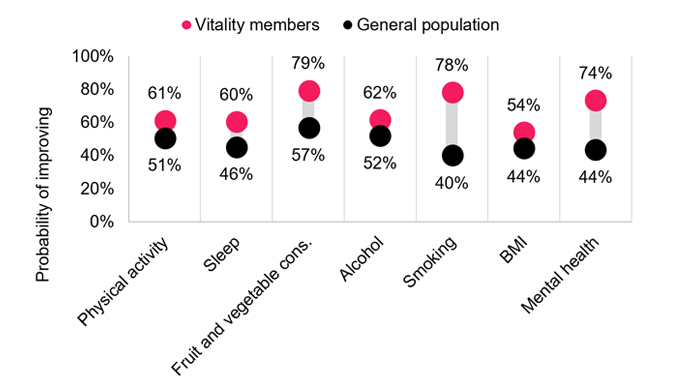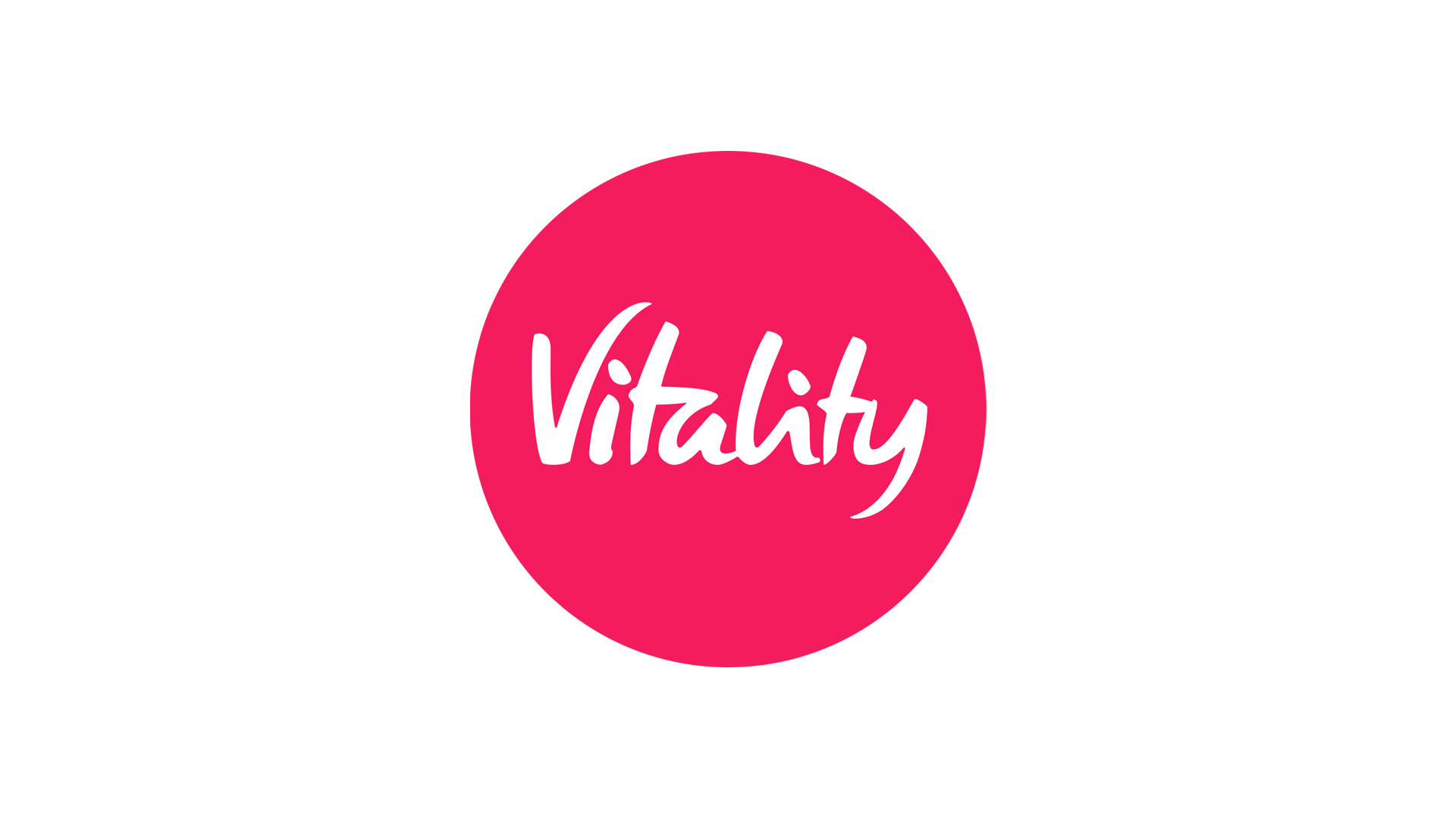
The Vitality Programme helps employees better understand their health and lifestyle habits and provides the necessary tools to develop healthier habits, leading to better health in the workplace
There is no doubt that we are living in extraordinary times. The COVID-19 pandemic has not only transformed the way we live our daily lives, but also placed our everyday health and wellbeing firmly in the spotlight.
Thanks to a rise in life expectancy, we are living longer but not necessarily healthier. Some of the most common chronic health conditions affecting us today are linked to behaviour and lifestyle. These lifestyle diseases include the likes of coronary heart disease, stroke, type 2 diabetes, some cancers, obesity, and hypertension. Recent figures show that heart disease, for example, was one of the leading causes of death in the UK (1)– a trend that has been developing for a number of years. (2)
Evidence suggests that the risk of developing these conditions could be reduced by implementing healthier lifestyle habits. A recent study of over 100,000 people, featured in the British Medical Journal, (3) looked at five healthy lifestyle habits that if adopted would have a positive impact on life expectancy and disease risk. These are: not smoking; maintaining a healthy BMI of between 18.5-24.9; getting at least 30 minutes of exercise a day; drinking less than two units (women) or four units (men) of alcohol a week and eating well (a diet score in the top 40% of people in the study). The study found that people who adopted at least four of these healthy habits were likely to live an extra seven to ten years, free of certain chronic health conditions and cancers, compared to those who adopted none.
One key factor that has emerged during the pandemic is the role that people’s age and health risk factors have to play in the risk of developing serious complications due to COVID-19, and in rates of survival among those who contract it. Some factors, such as age, cannot be changed. However, in line with published research, insights from Vitality conclude that the body’s ability to fight the virus and its negative consequences can be impacted significantly by lifestyle factors. It is something that has received significant public exposure from early in the pandemic, when these groups were identified as clinically vulnerable and considered at much higher risk of hospitalisation. The Government subsequently launched a campaign to tackle one risk factor – obesity – as part of its pandemic response. (4) Around two-thirds of UK adults are classed as overweight and the policy paper for the campaign stated that there is ‘consistent evidence’ this group in particular are more likely to suffer complications from the virus. Even the Prime Minister commented on his experience with being overweight and falling seriously ill after contracting COVID-19.
The results of our business health survey, Britain’s Healthiest Workplace (BHW), show that some of these health trends are worsening among the UK’s working population. In recent years, businesses have paid increasing attention to the health and wellbeing of their workforce, because of its proven impact on engagement and productivity – with many investing in business health initiatives. Results show that health and wellbeing leads to improved work engagement and reduced productivity loss through absenteeism and presenteeism (where a person is present at work but not functioning at full capacity because of poor physical or mental health).
However, between 2015 and 2019 the rate of BHW respondents who were not eating a healthy diet and could be considered obese rose by 27.5%. The results of respondents who had moderate or severe symptoms of depression, were even more alarming, increasing by 107.3%. (5) Good health is more important now than ever – not only for general wellness among the population, but also for the added benefit of better COVID-19 outcomes. As we spend around a third of our lives at work (6), employers have a huge role to play in improving the health of their employees. This has been especially important during the absence of an effective national vaccination programme and the uncertainty around COVID-19 risk going forward, or indeed any other future widespread health crisis.
The pressures of modern life and work mean we are busier and more stressed now than we have ever been, which means our health can often take a backseat. We have found that people are not always aware of their health, or overestimate how healthy they are and as a result, only seek help once a health issue has arisen. Socio-economic factors are also relevant, so as an employer, it is important that any workplace health solutions cover the whole workforce, as it is often those at the lower end of the pay-scale who are most impacted.
Therefore, encouraging healthy living has always been fundamental in our approach and it is underpinned in our core purpose: to make people healthier and to enhance and protect their lives.
The Vitality Programme’s approach to health in the workplace
Our Vitality at Work offering utilises behavioural science, as well as an ongoing wealth of member data to empower people to take charge of their health. It offers a unique health and engagement proposition and gives employers a cost-effective way to give their entire employee population access to health support, without necessarily having to enrol them on a health plan.
The Vitality Programme’s approach is three-fold and addresses some of the most common pain points around health:
Firstly, it seeks to give a better understanding of health. For employees, this is through online health reviews and health checks that provide a snapshot of their current lifestyle habits and baseline health measurements, which can help to identify any potential areas of concern. All employees are also provided with their Vitality Age, a measure of how their individual health compares to others of the same age. For employers, the data is anonymised to provide an overview of the health of their workforce, highlighting any common trends or issues.
Secondly, the Programme aims to improve employees’ health. Employers can use the data provided in step one to inform their decisions around health strategy and to create effective workplace wellness based on their employees’ needs. For employees, we signpost them to useful interventions based on their Health Review and health check results. The Vitality Programme then provides access to a wealth of partners and benefits, carefully selected to give people the necessary tools to develop healthier habits. These include health-focused elements, like discounted gym membership, sports shoes and activity trackers to encourage exercise, as well as access to healthy weight loss and smoking cessation programmes and access to leading mindfulness apps.
The final step is rooted in behavioural science and is the cornerstone of the Programme. We provide employees with access to tangible rewards when they take steps to be healthy. By exercising regularly and tracking their activity with us, they can earn regular rewards with our Active Reward partners, which gives employees access to blockbuster movies at home and handcrafted coffees. By having regular health checks and taking care of their mental wellness with our partner apps, they can also earn points towards unlocking additional tiers of rewards to promote long-term change. The ultimate goal is not just to encourage a temporary change in behaviour, but to create better long-term habits that should contribute to a healthier, happier life. This element forms the basis of our Shared Value proposition. Better health improves productivity and allows employers to give some of the subsequent savings back to employees.
Employers get access to ongoing reporting, that tracks the health of their workforce across time, and provides useful insights to help continuously improve their health strategy. Employee participation in the Vitality Programme yields the additional benefit of a more engaged and productive workforce. More than this, in the current climate both employers and employees may also benefit from being better protected against the ill-effects of COVID-19, thanks to improved health.
On top of this, employees are impacted by other risk areas, such as: depression; financial concerns; work demands and pressure; lack of sleep; lack of physical activity and musculoskeletal problems. Based on this, Vitality at Work employees get access to a comprehensive employee assistance programme, which can provide counselling and advice for financial, mental and emotional concerns. As well as this, it provides a dedicated online mental health support platform, access to care support for employees and their family members and access to, or discounts on physiotherapy services (depending upon product).
The Vitality Programme is proven to improve individual health. Across seven key lifestyle factors, members engaged with the Vitality Programme were at least 10% more likely to improve compared to the general population:

Our most recent data also shows that 26% of Vitality members who completed an annual Health Review improved their diet within the first year of participating in the Programme. 42% started doing more exercise and 28% showed a lower risk for depression than when they joined the Programme. Employees in the Vitality Programme were five times more engaged than those enrolled in other workplace wellness programmes, as well as having 12.2% greater productivity. The benefits are not just health-related though, the Programme also provided an estimated £103m worth of value (through rewards and benefits) to members in 2019. (7)
Our goal, to have a tangible impact on people’s general health and quality of life, is perpetual, but within the context of a global pandemic, it also makes a difference in protecting people against the virus. To put it into context, we estimate that someone aged 65 who is highly engaged in their health and wellness could experience a 22% lower COVID-19 mortality risk than an unengaged 45-year-old, and similar patterns are observable for other diseases and conditions as well. Beyond COVID-19, increased life expectancy and the number of years lived in good health can help reduce the risks associated with ageing and chronic conditions.
The benefits of this are reflected across all areas of life. It is good for society and our health services, and good for the economy.
Want to provide better health outcomes for your workforce? Get in touch for a consultation – Jill Pritchard Director, Vitality at Work.
- https://www.ons.gov.uk/peoplepopulationandcommunity/birthsdeathsandmarriages/deaths/bulletins/monthlymortalityanalysisenglandandwales/august2020#:~:text=This%20is%20in%20line%20with,100%2C000%20persons%2C%203%2C618%20deaths).
- https://www.who.int/news-room/fact-sheets/detail/the-top-10-causes-of-death
- https://www.bmj.com/content/368/bmj.l6669
- https://time.com/5872175/boris-johnson-weight-loss-coronavirus/
- BHW stats 2019 (Vitality data)
- https://www.gettysburg.edu/news/stories?id=79db7b34-630c-4f49-ad32-4ab9ea48e72b&pageTitle=1%2F3+of+your+life+is+spent+at+work#:~:text=The%20average%20person%20will%20spend%2090%2C000%20hours%20at%20work%20over%20a%20lifetime.
- Vitality Data

























